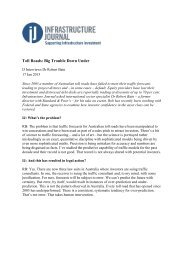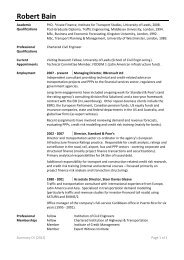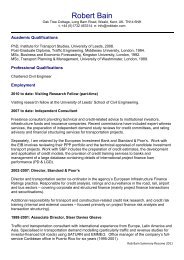Disincentivising overbidding for toll road concessions
Disincentivising overbidding for toll road concessions
Disincentivising overbidding for toll road concessions
- No tags were found...
You also want an ePaper? Increase the reach of your titles
YUMPU automatically turns print PDFs into web optimized ePapers that Google loves.
A3 │ TRAFFIC AND REVENUE REPORTS: BEST PRACTICE<br />
Discuss What the Results Mean<br />
Some traffic and revenue reports leave the reader with the distinct impression that the <strong>for</strong>ecasts were produced at<br />
a very late stage in the study. They are presented, fait accompli, at the end of the report – perhaps in a table – with<br />
little or no explanatory text. This is unhelpful. Investors need to know, not only what the results are, but what they<br />
mean. Is a <strong>for</strong>ecast of 24,000 vehicles/day in the year 2015 high or low Is it unexpected, in line with other <strong>toll</strong> <strong>road</strong><br />
per<strong>for</strong>mance or what Traffic consultants would add considerable value to their work if an explanatory commentary<br />
and/or discussion followed on from the presentation of their projections.<br />
Provide a Candid Description of Future Uncertainties and Modelling Limitations<br />
In academic literature researchers are required to bring to their readers’ attention any limitations associated with<br />
their work. It would be helpful if the authors of traffic and revenue studies adopted this practice. Instead of providing<br />
pseudo-com<strong>for</strong>t to potential investors, the avoidance of any discussion about modelling limitations – or other sources<br />
of uncertainty which could impact on future cash flows – simply serves to undermine confidence. This is especially<br />
true when these limitations and uncertainties become apparent only under later cross-examination.<br />
Provide Consistency in Terms of Risk Analysis Reporting<br />
One of the challenges facing the reviewers of <strong>toll</strong> <strong>road</strong> traffic and revenue study reports is the lack of consistency in<br />
terms of reporting content and style. This is most evident when considering project risks and the technical advisor’s<br />
commentary on investors’ residual risk exposure. It would be useful if a common risk register or template was used<br />
by way of a summary. This would enable investors to build-up their analytical experience and expertise over time and,<br />
importantly, would assist with the project comparisons and benchmarking often used in credit analysis.<br />
This type of template has already been developed, although it is employed by different traffic consultancies to<br />
different degrees. At Standard & Poor’s we developed a ‘Traffic Risk Index’, based on years of credit risk analysis<br />
specifically focused on <strong>toll</strong> <strong>road</strong> risks (see www.robbain.com <strong>for</strong> more detail). Key project risks are scored on a single<br />
summary sheet using a simple 10-point scale. Wider use of this template (or an alternative that fulfils the same role)<br />
would summarise the main project risks quickly and would help investors to apply more consistency to their analytical<br />
endeavours.<br />
Commission an Independent Peer Review<br />
As a condition of receiving state support, some programmes – such as the TIFIA programme in the United States –<br />
require independent peer reviews to be conducted of <strong>toll</strong> <strong>road</strong> traffic and revenue <strong>for</strong>ecasts. This is good industry<br />
practice as it provides oversight of the original study by technically-conversant professionals, thus enhancing<br />
investor confidence. Selection of the impartial peer reviewer, however, is critical. Some are less rigorous than others,<br />
suggesting a possible reluctance to be critical of parties who – next time around – might be conducting the peer<br />
review process themselves.<br />
75






